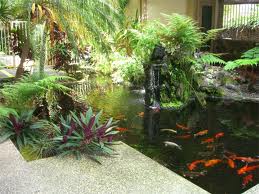





The care and maintenance necessary for a koi pool differs considerably from that required by a conventional garden pool, for the focus is very much on the fish. Although the aquatic environment must be right, the condition of the fish and their behaviour will be of the greatest concern.

Spring is the most difficult time for the koi keeper, for having come through the winter, the fish are likely to be run down, despite any hearty feeding and preparation in the previous autumn. Koi always give of their best in a water temperature of 18-24°C (65-75°F), and much prefer the shorter winters of their Japanese homeland to the extended cold and fluctuating temperatures of short winter days in northern latitudes. Although they will survive most winters without difficulty, inevitably they will be in poor condition and will not improve until the water temperature rises and they begin to feed actively again.
Koi that are not in the best of spirits will be vulnerable to infections. As they become more active, inspect them carefully. Provided the water quality has been maintained to a high standard throughout their period of winter torpor, you are unlikely to find anything untoward, but if a problem is spotted, it must be dealt with promptly.
As spring moves on and slowly turns to summer, the fish will demand more food. However, do not simply feed greater amounts at a specific time each day, but rather dispense it more often. When possible, feed five or six times a day, using a good high-protein food. Do not skimp on its quality; large quantities of mediocre food will not have the same effect as the controlled feeding of a scientifically formulated food.
Koi sticks are the most popular artificial food, but this diet can he supplemented with occasional treats. If you come across earthworms when digging the garden, throw them into the pool, as the koi will be very appreciative. They will feed on all manner of aquatic insect life too, and also enjoy eating vegetable matter. This is why there is little point in introducing good aquatic plants, for the koi will simply destroy them. However, aquatic plants are not necessary to provide the green stuff in their diet; any succulent leafy material will do. For example, tie a string to the stalk of a lettuce, so that it can be anchored, and place it in the pool. The fish will take a little time to get used to it, but eventually will eat it with relish.
Apart from improving the health of the koi, providing a varied diet and controlling their method of feeding make it more likely that the fish will become hand tame. Once this has been achieved, netting and inspecting the fish, when necessary, will be much easier.
The quality of water in the summer is particularly critical. Everything seems to happen much more quickly during hot weather, which means that problems can occur almost instantaneously. Regular maintenance is vital: settlement areas must be flushed daily, while once a week the floor of the pond must be vacuumed to clear those areas beyond the influence of the bottom drain. Other weekly tasks are back flushing the filter chambers and the routine testing of the water for pH, nitrite and ammonia levels.
Most koi keepers believe that, in hot weather, up to 20 per cent of the water volume should be changed each week. This should be reduced to 10 per cent in cooler weather, and as little as 5 per cent during winter. The fresh water must always be fed through a purifier or treated with a tap water conditioner to prevent any unexpected pollutants in the water from harming the fish.
Throughout the spring and summer season, check the water quality carefully. All may seem well, but if the fish start to flick and turn themselves over in flashes on the floor of the pool, it may not be the case. This distinctive behaviour may be a sign of parasites, but it is much more likely to be due to a temporary shift in water quality. Test for pH, ammonia and nitrite, for the last in particular can occur through increased feeding in warm conditions. In this case, the filter system may need improving. In warm weather, oxygen may also be in short supply, and it may be necessary to use a pond air-pump to increase the oxygen level.
As autumn and winter approach, it is essential to prepare koi for their ordeal. Temperatures below 10°C (50°F) create stress in koi, and once they drop below 5°C (41°F), the process that controls digestion and the absorption of food ceases altogether. Once water temperatures have reached these levels, continued feeding is pointless. Until then, it is important to feed liberally and regularly, with high-quality wheatgerm foods, to build up the fish for the winter. In some cases, freshly purchased young koi will not survive their first winter, but larger fish, which have become acclimatized to the pool during an entire season, usually present few problems if they feed properly before the chill weather descends. You should continue to feed wheatgerm foods when the fish are active during the winter period.
Copyright © www.100flowers.win Botanic Garden All Rights Reserved